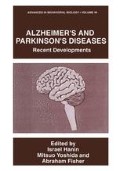Abstract
The “cholinergic deficit hypothesis” provided the first theoretical framework for developing rational, palliative treatments for the cognitive loss associated with Alzheimer’s Disease (AD). The hypothesis arose from the synthesis of several lines of evidence showing the importance of central cholinergic function to normal cognition, and the relationship between AD dementia and the loss of cholinergic innervation to the neocortex and hippocampus (for a review see Davis et al., 1993). The “hypothesis” led to the testing of agents to restore central cholinergic function. A variety of replacement therapies were tried including inhibitors of acetylcholinesterase (AChE) to increase brain levels of acetylcholine. Initial studies using the anticholinesterase physostigmine provided suggestive evidence that such an approach might be beneficial (for a review see Kumar and Calache, 1991). However, early clinical results with tacrine (THA, Cognex®) sparked the effort to evaluate thoroughly the efficacy of cholinesterase inhibitors in the treatment of AD.
Access this chapter
Tax calculation will be finalised at checkout
Purchases are for personal use only
Preview
Unable to display preview. Download preview PDF.
References
Ashour, A., Gee, S. J., and Hammock, B. D., 1987, Use of a 96-well microplate reader for measuring enzyme activities, Anal. Biochem. 166: 353.
Berridge, M. J., Downes, C. P., and Hanley, M. R., 1982, Lithium amplifies agonist-dependent phosphatidylinositol responses in brain and salivary glands, Biochem. J. 206: 587.
Davis, K. L., Thal, L. J., Gamzu, E. R., Davis, C. S., Woolson, R. F., Gracon, S. I., Drachman, D. A., Schneider, L. S., Whitehouse, P. J., Hoover, T. I., Morris, J. C., Kawas, C. H., Knopman, D. S., Earl, N. L., Kumar, V. and Doody, R. S., 1992, A double-blind, placebo-controlled multicenter study of tacrine for Alzheimer’s Disease, New Engl. J. Med. 327: 1253.
Davis, R. E., Emmerling, M.R., Jaen, J. C., Moos, W. H. and Spiegel, K., 1993, Therapeutic intervention in dementia, Crit. Rev. Neurobiol. 7: 41.
Duggleby, R. G., 1988, Determination of inhibition constants, IC50 values and the type of inhibition for enzyme-catalyzed reactions, Med. Metab. Biol. 40: 204.
Emmerling, M. R., and Sobkowicz, H. M., 1988, Differentiation and distribution of acetylcholinesterase molecular forms in the mouse cochlea, Hearing Res. 32: 137.
Farlow, M., Gracon, S. I., Hershey, L. A., Lewis, K. W., Sadowsky, C. H., and Dolan-Ureno, J., 1992, A controlled trial of tacrine in Alzheimer’s Disease, JAMA 268: 2523.
Johnson, C. D. and Russell, R. L., 1975, A rapid, simple radiometric assay for cholinesterase for multiple determinations, Anal. Biochem. 64: 229.
Krupka, R. M. and Ladler, K. J., 1961, Molecular mechanisms for hydrolytic enzyme action. I. Apparent noncompetitive inhibition with a special reference to acetylcholinesterase, J. Amer. Chem. Soc. 83: 1445.
Kumar, V., and Calache, M., 1991, Treatment of Alzheimer’s disease with cholinergic drugs, Int. J. Clin. Pharm. Ther. Tox. 29: 23.
Summers, W. K., Majovski, L. V., Marsh, G. M., Tachiki, K., and Kling, A., 1986, Oral tetrahydroaminoacridine in long-term treatment of senile dementia, Alzheimer’s type, New. Engl. J. Med. 315: 1241.
Sussman, J. L., Harel, M., Frolow, F., Oefner, C., Goldman, A., Toker, L., and Silman, I., 1991, Atomic structure of acetylcholinesterase from Torpedo californica: a prototypic acetylcholine-binding protein., Science 253: 872.
Symons, J. P., Davis, R. E., and Marriott, J. G., 1988, Water-maze learning and effects of cholinergic drugs in mouse strains with high and low hippocampal pyramidal cell counts, Life. Sci. 42: 375.
Ungerstedt, U., 1987, In vivo microdialysis: A new approach to the analysis of neurotransmitters in the brain, Life Sci. 41: 861.
Watson, M., Yamamura, H., and Roeske, W. R., 1986, [3H]pirenzepine and (-)-[311]quinuclidinyl benzilate binding to rat cerebral cortical and cardiac muscarinic cholinergic sites. II. Characterization and regulation of antagonist binding to putative muscarinic subtypes, J. Pharmacol. Exp. Ther. 237: 4114.
Wimer, R., and Wimer, C. C., 1981, A biometrical-genetic analysis of granule cell number in the area dentate of house mice, Brain Res. 254: 129.
Xu, M., Nakamura, Y., and Yamamoto, T., 1991, Determination of basal acetylcholine release in vivo by rat brain dialysis with a U - shaped cannula: Effect of SM-10888, a putative therapeutic drug for Alzheimer’s disease, Neurosci. Leu. 123: 179.
Author information
Authors and Affiliations
Editor information
Editors and Affiliations
Rights and permissions
Copyright information
© 1995 Springer Science+Business Media New York
About this chapter
Cite this chapter
Emmerling, M.R. et al. (1995). CI-1002, a Novel Anticholinesterase and Muscarinic Antagonist. In: Hanin, I., Yoshida, M., Fisher, A. (eds) Alzheimer’s and Parkinson’s Diseases. Advances in Behavioral Biology, vol 44. Springer, Boston, MA. https://doi.org/10.1007/978-1-4757-9145-7_71
Download citation
DOI: https://doi.org/10.1007/978-1-4757-9145-7_71
Publisher Name: Springer, Boston, MA
Print ISBN: 978-1-4757-9147-1
Online ISBN: 978-1-4757-9145-7
eBook Packages: Springer Book Archive

